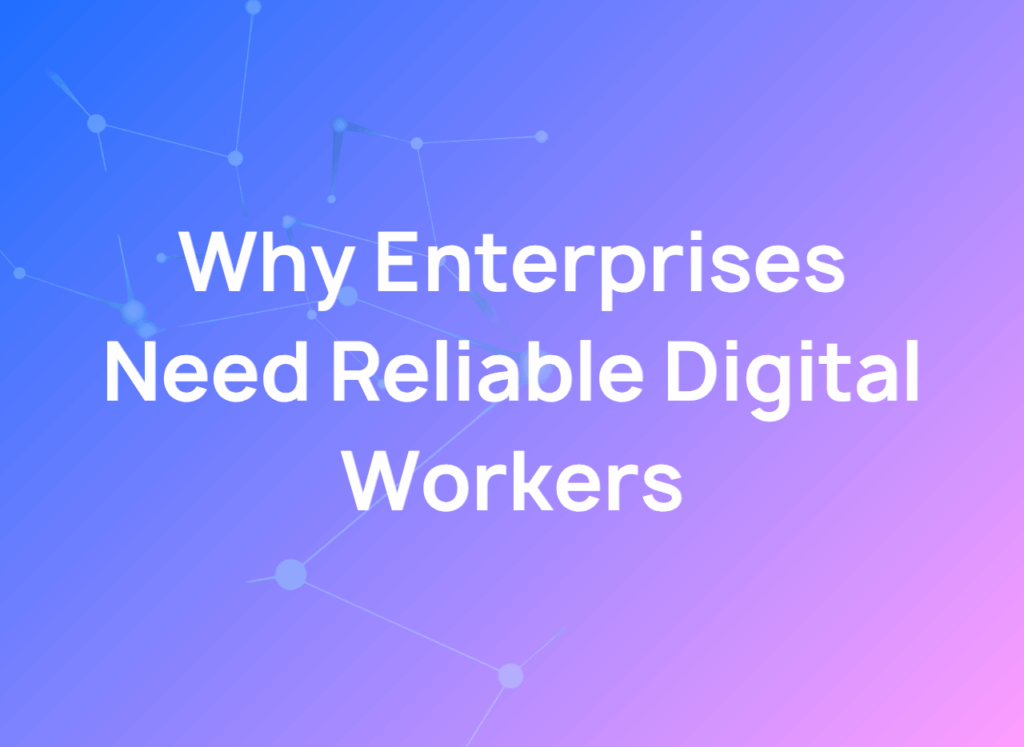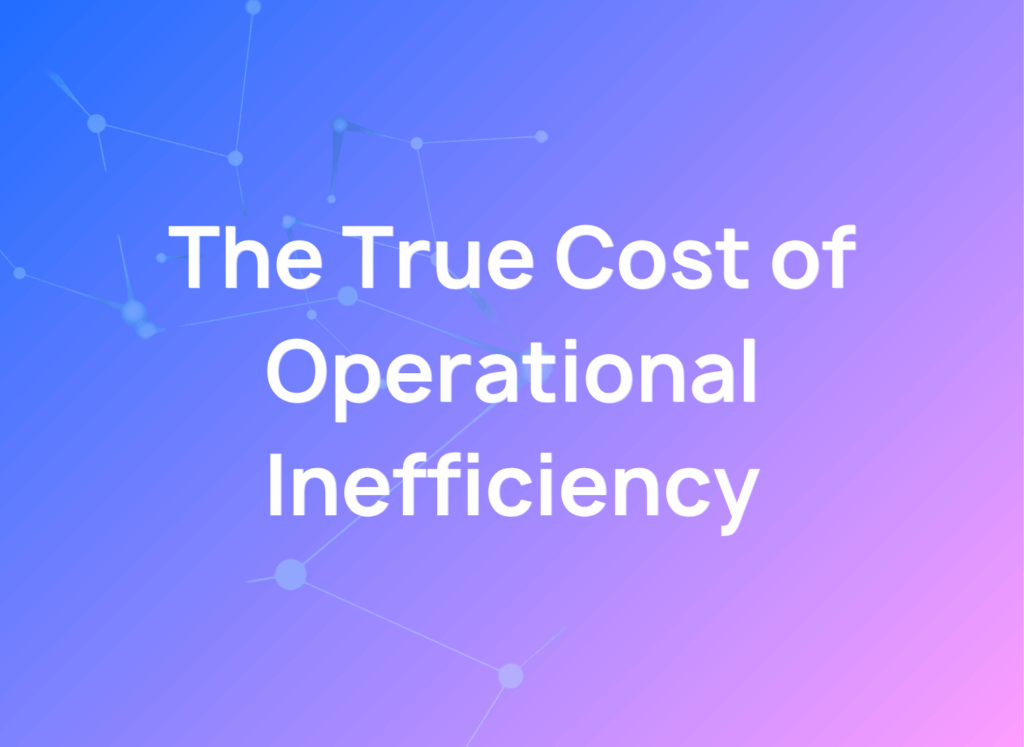How to Optimize Inventory Without Stockouts Using AI Digital Workers
How to Optimize Inventory Without Stockouts Using AI Digital Workers
Inventory management has become the ultimate balancing act for operations executives. Too much stock ties up capital and increases carrying costs. Too little creates stockouts that damage customer relationships and lost revenue. Traditional approaches can't keep pace with market volatility, supply chain disruptions, and changing consumer behavior.
The solution isn't hiring more analysts or buying another forecasting tool. It's deploying AI-powered Digital Workers that transform inventory optimization from reactive guesswork into proactive intelligence. These autonomous agents don't just predict demand—they orchestrate your entire inventory ecosystem in real-time.
Why Traditional Inventory Management Falls Short
Traditional inventory management relies on historical patterns and manual processes that break down when markets shift. Static forecasting models assume yesterday's patterns will predict tomorrow's demand. Manual replenishment processes create delays between insight and action. Fragmented data sources prevent holistic visibility across channels and locations.
The result? 37% of retailers experienced stockouts in 2024, while excess inventory costs businesses an average of 20-30% of total inventory value annually. Operations executives face impossible choices: accept stockouts and lost sales, or carry excess inventory that drains working capital.
Human-driven processes simply can't process the volume and complexity of modern inventory decisions. A mid-market retailer might manage 50,000 SKUs across multiple channels, each with unique demand patterns, supplier constraints, and seasonal variations. Traditional teams spend weeks analyzing what Digital Workers can process in minutes.
Introducing AI-Powered Digital Workers for Inventory
Digital Workers represent a fundamental shift from inventory management tools to autonomous inventory intelligence. These aren't dashboards or forecasting platforms—they're AI agents that execute end-to-end inventory workflows without human intervention.
Digital Workers operate like virtual inventory managers who never sleep, never miss a pattern, and never make emotional decisions. They continuously monitor demand signals, supplier performance, and market conditions, adjusting inventory levels in real-time to maintain optimal stock positions.
Unlike traditional automation that breaks when exceptions occur, Digital Workers adapt to changing conditions. They understand causality—not just correlation—enabling them to distinguish between temporary fluctuations and fundamental demand shifts.
How Digital Workers Transform Inventory Optimization
Advanced Demand Forecasting with Causal Intelligence
Digital Workers analyze millions of demand variables simultaneously, from weather patterns and social media trends to economic indicators and competitive actions. They don't just predict what will happen—they understand why it's happening and how to respond.
Traditional forecasting relies on historical sales data and seasonal patterns. Digital Workers incorporate real-time signals like social media sentiment, competitor pricing, weather forecasts, and economic indicators. They identify causal relationships that human analysts miss, predicting demand shifts before they impact sales.
For example, a Digital Worker might detect that unseasonably warm weather combined with increased social media activity around outdoor activities will drive higher demand for specific SKUs three weeks ahead of traditional forecasts. This enables proactive inventory positioning rather than reactive scrambling.
Autonomous Replenishment Optimization
Digital Workers execute intelligent replenishment strategies that balance service levels, carrying costs, and supplier constraints. They continuously optimize order quantities, timing, and supplier selection based on real-time conditions.
Dynamic safety stock calculations adjust automatically based on demand variability, supplier reliability, and strategic importance. Intelligent order batching consolidates shipments to minimize transportation costs while maintaining service levels. Supplier performance monitoring triggers automatic sourcing adjustments when quality or delivery issues emerge.
The result is inventory that flows seamlessly through your supply chain with minimal human intervention. Digital Workers handle routine decisions autonomously while escalating strategic decisions to human executives with comprehensive analysis and recommendations.
Waste Reduction Through Predictive Analytics
Digital Workers identify inventory risks before they become costly problems. They predict which products will face obsolescence, which suppliers will experience delays, and which channels will drive unexpected demand.
Predictive spoilage models for perishable goods optimize rotation schedules and markdown timing. Obsolescence prediction identifies slow-moving inventory for proactive liquidation. Channel optimization redistributes inventory across locations and channels to maximize sell-through.
One causaLens customer reduced inventory write-offs by 40% within six months by deploying Digital Workers that identified at-risk inventory and automatically triggered markdown and redistribution workflows.
Quantifiable Benefits and ROI
Immediate Cost Reduction
Digital Workers deliver measurable cost savings through optimized inventory levels and reduced manual effort. Inventory carrying costs typically decrease by 15-25% through more precise demand forecasting and automated replenishment optimization.
Labor cost savings emerge as Digital Workers eliminate the need for large analytical teams. A typical mid-market retailer might save $500K annually by replacing manual forecasting and replenishment processes with autonomous Digital Workers.
Stockout reduction directly impacts revenue. A 10% reduction in stockouts typically translates to 2-4% revenue increase for retailers, while improved inventory turns free up working capital for growth investments.
Operational Efficiency Gains
Digital Workers operate continuously without fatigue, vacation, or training requirements. They process inventory decisions in minutes rather than days, enabling faster response to market changes.
Decision speed increases dramatically. Traditional inventory planning cycles that take weeks compress to hours. Data processing capacity scales infinitely—Digital Workers analyze millions of SKUs as easily as hundreds.
Exception handling improves significantly. Digital Workers identify and resolve 80% of inventory issues automatically, escalating only complex strategic decisions to human managers with comprehensive analysis and recommendations.
Enhanced Strategic Decision-Making
Digital Workers provide operations executives with unprecedented visibility into inventory performance and optimization opportunities. They don't just report what happened—they explain why it happened and recommend specific actions.
Causal analysis reveals the true drivers of inventory performance, enabling strategic adjustments to supplier relationships, product mix, and channel strategy. Scenario planning models the impact of different inventory strategies under various market conditions.
Competitive intelligence integration helps optimize inventory positioning relative to market dynamics and competitor actions. Digital Workers continuously monitor competitor pricing, promotions, and availability to inform inventory decisions.
Real-World Success Stories
Cisco: Transforming Demand Forecasting with AI Agents
Cisco is revolutionizing demand forecasting with causaLens AI agents, scaling analytics across 10,000+ products, 10 business units, and a global multi-billion-dollar supply chain.
The Challenge:
Forecasting demand across a complex supply chain with thousands of models and features was time-intensive and limited by human bandwidth and trust issues.
The Solution:
Cisco implemented causaLens AI agents to automate key forecasting tasks, from exploratory data analysis to model inspection and explanation. These agents act as “PhD-level economists,” learning from past data, reasoning across business contexts, and delivering forecasts with clear causal narratives.
Results Achieved:
- Faster model development and feature selection.
- Scalable insights, even for less-prioritized models.
- Business-friendly forecasts with causal explanations.
- Reduced reliance on senior analysts for decision-making.
By integrating AI agents, Cisco is building a digital workforce where humans and technology collaborate to improve forecasting accuracy and efficiency—paving the way for supply chain excellence.
Addressing Implementation Challenges
Data Integration and Quality
Digital Workers require high-quality data from multiple sources. causaLens provides comprehensive data integration capabilities that connect to existing ERP systems, supplier portals, and external data sources.
Data quality issues are addressed through automated cleansing and validation processes. Integration complexity is managed through pre-built connectors and APIs that minimize IT overhead.
Change management support ensures smooth adoption across teams and processes. Digital Workers enhance human capabilities rather than replacing them, focusing on collaboration and augmentation.
Scalability and Performance
Digital Workers are designed for enterprise-scale operations. They handle millions of SKUs, thousands of suppliers, and complex multi-channel environments without performance degradation.
Cloud-native architecture provides unlimited scalability and reliability. Real-time processing ensures inventory decisions reflect current market conditions. Enterprise security protects sensitive inventory and supplier data.
Customization and Flexibility
Every business has unique inventory challenges and requirements. causaLens Digital Workers are custom-built through our proprietary Digital Labor Factory, ensuring they fit your specific processes and objectives.
Industry-specific blueprints accelerate deployment while maintaining customization. Continuous learning capabilities enable Digital Workers to adapt to changing business conditions and requirements.
The Future of Inventory Optimization
Digital Workers represent the evolution of inventory management from reactive tools to proactive intelligence. They enable operations executives to move from managing inventory problems to orchestrating inventory opportunities.
Predictive capabilities will continue advancing, incorporating more sophisticated market signals and causal relationships. Automation scope will expand to include supplier negotiations, product lifecycle management, and strategic sourcing decisions.
Integration depth will increase, connecting inventory optimization directly to demand planning, production scheduling, and customer experience management. Digital Workers will become the autonomous nervous system of modern supply chains.
Transform Your Inventory Operations Today
The inventory optimization challenge won't solve itself with traditional approaches. Market volatility, supply chain complexity, and customer expectations continue increasing while resources remain constrained.
Digital Workers offer a proven path to inventory excellence. They deliver the intelligence, automation, and scalability necessary to optimize inventory levels without stockouts while reducing costs and improving customer satisfaction.
The organizations that deploy Digital Workers today will define the competitive standards of tomorrow. They'll achieve inventory optimization that seemed impossible with traditional methods while freeing their teams to focus on strategic growth initiatives.
Ready to transform your inventory operations? Discover how causaLens Digital Workers can optimize your inventory levels without stockouts while delivering measurable ROI. Explore our retail solutions and see how leading organizations are achieving inventory excellence through autonomous AI agents.
The future of inventory management is autonomous, intelligent, and available today. The question isn't whether Digital Workers will transform inventory optimization—it's whether your organization will lead this transformation or follow it.
Ready to Transform Your Ops?
Get started today with Digital Workers that take on operational and analytical processes.
Frequently Asked Questions
AI-driven inventory optimization refers to the use of artificial intelligence to analyze data, predict demand, and automate inventory processes. By leveraging machine learning algorithms, businesses can achieve better accuracy in demand forecasting and streamline inventory replenishment.
AI minimizes inventory waste by analyzing real-time data to determine optimal stock levels. It identifies slow-moving or excess inventory and adjusts replenishment schedules, ensuring resources are allocated efficiently and reducing overstock or expired goods.
Industries like retail, manufacturing, e-commerce, healthcare, and food services benefit significantly. These sectors often deal with high inventory volumes and can leverage AI to precisely predict trends, prevent shortages, and reduce waste.
Yes, AI prevents stockouts by continuously monitoring sales data, demand fluctuations, and supply chain dynamics. It ensures timely replenishment using predictive analytics and machine learning, so businesses can maintain consistent inventory availability.
Absolutely. From small businesses to multinational corporations, AI solutions can be tailored to fit unique operational needs. Scalable AI tools empower organizations of any size to enhance efficiency, reduce costs, and boost overall profitability.





